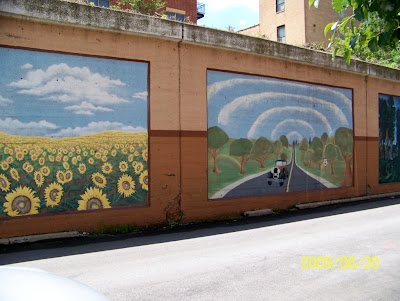One of the most frequent questions for those who have lived or studied in, or simply passed through Hyde Park for any length of time, is why it does not more closely resemble other campus towns they have known. Certainly, not all campus towns are desirable models. I can think of a number of larger state schools in the Midwest that have expanded in the form of parking lots and drab student housing to consume the old American village that once surrounded it.
This isn't the case with Ann Arbor, Michigan. To the immediate northwest of the University of Michigan campus sits a roughly 10-square block area that makes up the "old downtown." It is a remarkably diverse commercial district adjacent to a major American university. It has upscale dining, it has ethnic quick eats. It has a cupcake shop, and a Chinese bakery specializing in fresh steamed buns and at least two chocolate shops.
It has fancy boutiques, whimsical ones, and non-profits that run storefronts for a variety of causes.
 Robot Supply and Repair
Robot Supply and RepairFront for 826michigan, a Non-Profit Tutoring and Writing Center
Founded by Dave Eggers in San Francisco,
Opened in Ann Arbor 2005
 The Workantile Exchange
The Workantile ExchangeA "Co-Working" Office Cooperative, With Cafe in Front
It has a garden supply store, a contemporary furniture store, and a brand new gym fronted by a juice bar. And as far as I could tell, it has only one Starbucks.
Most importantly, old downtown Ann Arbor is a pleasure to walk around and explore. It seems to pull together most of what past surveys and workshops say people want in Hyde Park: lots of dining, lots of al fresco seating, independent retail, and boutique shopping.
It manages to sustain a core of local enterprises that does not resemble the Banana Republic/Restoration Hardware/California Pizza Kitchen real estate "product" that is so common in new retail development. In the midst of all this, there is room for alternative or non-profit operations that use their business to fund other operations.
Of course, Hyde Park is a neighborhood in an economically distressed region of Chicago, and relies on a single large employer of around 12,000 people to drive the local economy. Ann Arbor is a city in its own right, with a Big 10 research university that itself employs around 38,000 people, while also hosting a cluster of tech and biomedical employers, all of which keep Ann Arbor's median household incomes higher than their Hyde Park equivalents. And as interesting as Ann Arbor's downtown area is, it is relatively low-density, and there are no major drug stores or supermarkets within walking distance. Since 2005, however, the city has embarked on a major effort to rezone downtown and outlying areas to encourage greater densities.
 A Thriving Commercial District
A Thriving Commercial DistrictRecently Added Density Around the Edges
"Since 2005, when Ann Arbor began rethinking building heights and downtown density, that small area of the city [downtown] has been in the spotlight." -- mlive.com
So Hyde Park is not completely at a disadvantage with regards to Ann Arbor. In the last two years, a number of positive changes, some small and some large, have taken place. There should be room for still more, assuming people understand what is required to bring them about.

































